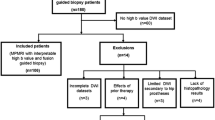Abstract
Objective
To investigate whether gadolinium-based contrast agent (GBCA) administration significantly affects diffusion-weighted imaging (DWI) at 3 T in the evaluation of prostate cancer and benign tissue.
Method
Thirty-four consecutive patients with surgically proven prostate cancer underwent preoperative DWI at 3 T before and after GBCA administration. Exponential apparent diffusion coefficient (EADC) and ADC maps were developed from DWI data. The ADC and EADC values pre- and post-contrast were measured in the cancer and benign tissue, respectively. The signal-to-noise ratio (SNR) and contrast-to-noise ratio (CNR) were evaluated on pre- and post-contrast DWI.
Results
The ADC and EADC values of the cancer and benign transition zone were not significantly different between pre- and post-contrast, respectively (P > 0.05), while those in the benign peripheral zone were significantly different (P = 0.030 and 0.037, respectively). In all tissues, the SNRs and CNRs of the DWI, ADC map and EADC map were not significantly different between pre- and post-contrast (P > 0.05). Between pre- and post-contrast, ADC and EADC values showed excellent agreement (intraclass correlation coefficient ≥ 0.894) and variability of ≤3.2 %.
Conclusion
Prostate 3 T-DWI after GBCA administration may be used without a significant difference in SNR or CNR, with minimal variability of the cancer ADC and EADC values.
Key Points
• ADCs and EADCs have excellent agreement before and after gadobutrol administration.
• SNRs of prostate DWI are similar before and after gadobutrol administration.
• CNRs of cancers are similar between pre- and post-contrast DWI.


Similar content being viewed by others
References
Barentsz JO, Richenberg J, Clements R et al (2012) ESUR prostate MR guidelines 2012. Eur Radiol 22:746–757
Mullins JK, Carter HB (2014) Multiparametric magnetic resonance imaging (MRI) and active surveillance for prostate cancer: future directions. BJU Int 113:844–845
de Rooij M, Hamoen EH, Futterer JJ, Barentsz JO, Rovers MM (2014) Accuracy of multiparametric MRI for prostate cancer detection: a meta-analysis. AJR Am J Roentgenol 202:343–351
Turkbey B, Choyke PL (2012) Multiparametric MRI and prostate cancer diagnosis and risk stratification. Curr Opin Urol 22:310–315
Park JJ, Kim CK, Park SY, Park BK, Lee HM, Cho SW (2014) Prostate cancer: role of pretreatment multiparametric 3-T MRI in predicting biochemical recurrence after radical prostatectomy. AJR Am J Roentgenol 202:W459–465
Futterer JJ, Briganti A, De Visschere P et al. (2015) Can clinically significant prostate cancer be detected with multiparametric magnetic resonance imaging? A systematic review of the literature. Eur Urol
Kim CK, Park BK, Kim B (2010) Diffusion-weighted MRI at 3 T for the evaluation of prostate cancer. AJR Am J Roentgenol 194:1461–1469
Provenzale JM, Engelter ST, Petrella JR, Smith JS, MacFall JR (1999) Use of MR exponential diffusion-weighted images to eradicate T2 "shine-through" effect. AJR Am J Roentgenol 172:537–539
Fishback SJ, Pickhardt PJ, Bhalla S, Menias CO, Congdon RG, Macari M (2011) Delayed presentation of splenic rupture following colonoscopy: clinical and CT findings. Emerg Radiol 18:539–544
Liu X, Zhou L, Peng W, Qian M (2011) Effect of intravenous gadolinium-DTPA on diffusion-weighted imaging for prostate lesions and normal tissue at 3.0-Tesla magnetic resonance imaging. Acta Radiol 52:575–580
Zhang YL, Yu BL, Ren J et al (2013) EADC values in diagnosis of renal lesions by 3.0 T diffusion-weighted magnetic resonance imaging: compared with the ADC values. Appl Magn Reson 44:349–363
Cruz M, Tsuda K, Narumi Y et al (2002) Characterization of low-intensity lesions in the peripheral zone of prostate on pre-biopsy endorectal coil MR imaging. Eur Radiol 12:357–365
Kim CK, Park BK, Lee HM, Kwon GY (2007) Value of diffusion-weighted imaging for the prediction of prostate cancer location at 3T using a phased-array coil: preliminary results. Invest Radiol 42:842–847
Ramadan S, Mulkern RV (2010) Comment on ADC reductions in postcontrast breast tumors. J Magn Reson Imaging 31:262, author reply 263–264
Choi JS, Kim MJ, Choi JY, Park MS, Lim JS, Kim KW (2010) Diffusion-weighted MR imaging of liver on 3.0-Tesla system: effect of intravenous administration of gadoxetic acid disodium. Eur Radiol 20:1052–1060
Yamada K, Kubota H, Kizu O et al (2002) Effect of intravenous gadolinium-DTPA on diffusion-weighted images: evaluation of normal brain and infarcts. Stroke 33:1799–1802
Janka R, Hammon M, Geppert C, Nothhelfer A, Uder M, Wenkel E (2014) Diffusion-weighted MR imaging of benign and malignant breast lesions before and after contrast enhancement. Röfo 186:130–135
Firat AK, Sanli B, Karakas HM, Erdem G (2006) The effect of intravenous gadolinium-DTPA on diffusion-weighted imaging. Neuroradiology 48:465–470
Acknowledgments
The scientific guarantor of this publication is Chan Kyo Kim. The authors of this manuscript declare no relationships with any companies whose products or services may be related to the subject matter of the article. Our study did not receive any governmental or other research funding. Sookyoung Woo, PhD, kindly provided statistical advice for this manuscript. Institutional Review Board approval was obtained. This retrospective study was approved by our institutional review board, with a waiver of the requirement for informed consent. No study subjects or cohorts have been previously reported in any studies. Methodology and Design: retrospective, diagnostic or prognostic study, performed at one institution.
Author information
Authors and Affiliations
Corresponding author
Rights and permissions
About this article
Cite this article
Kim, C.K., Park, J.J. & Park, B.K. Prostate diffusion-weighted imaging at 3T: effect of intravenous gadobutrol administration. Eur Radiol 26, 1450–1456 (2016). https://doi.org/10.1007/s00330-015-3942-6
Received:
Revised:
Accepted:
Published:
Issue Date:
DOI: https://doi.org/10.1007/s00330-015-3942-6




